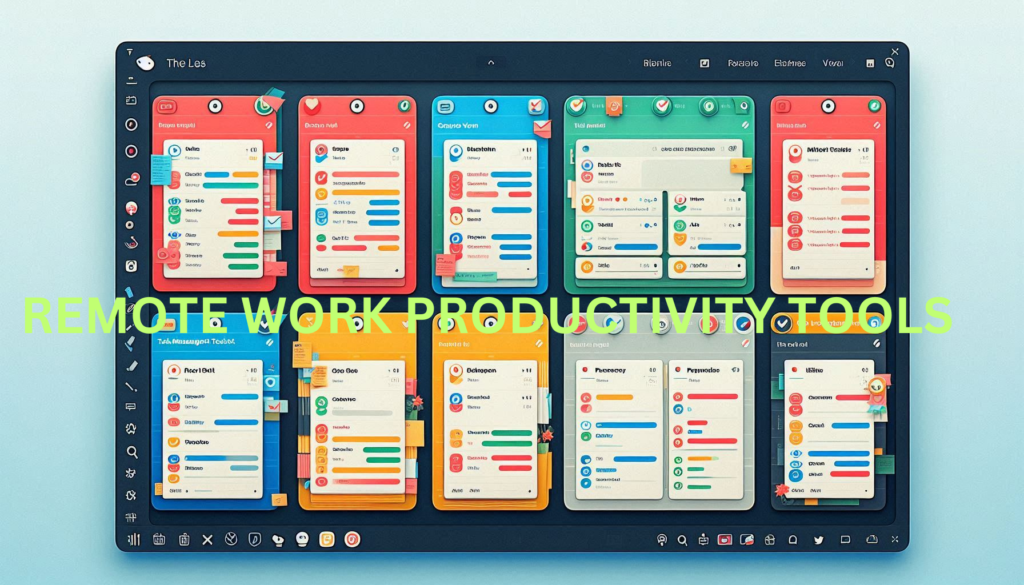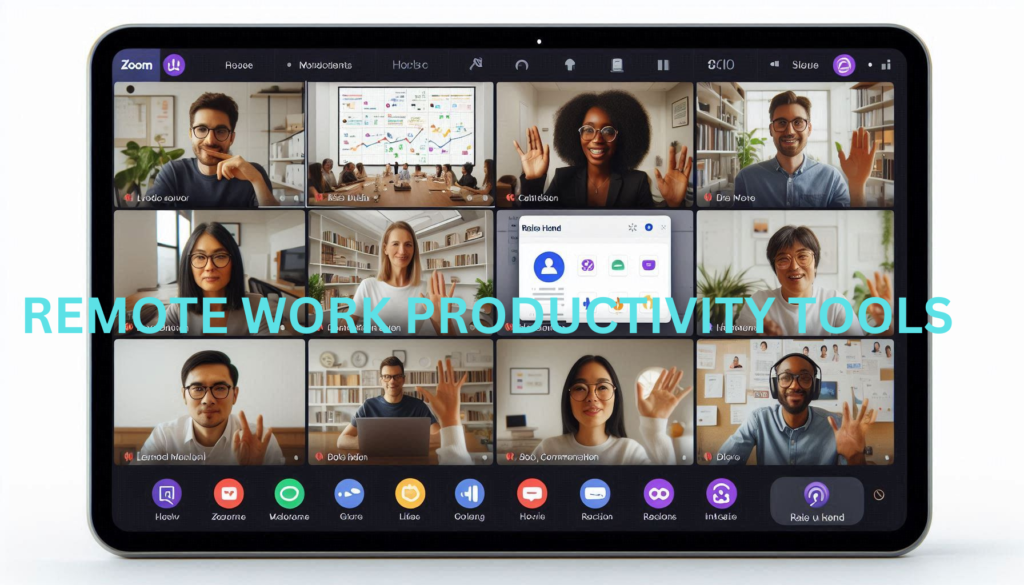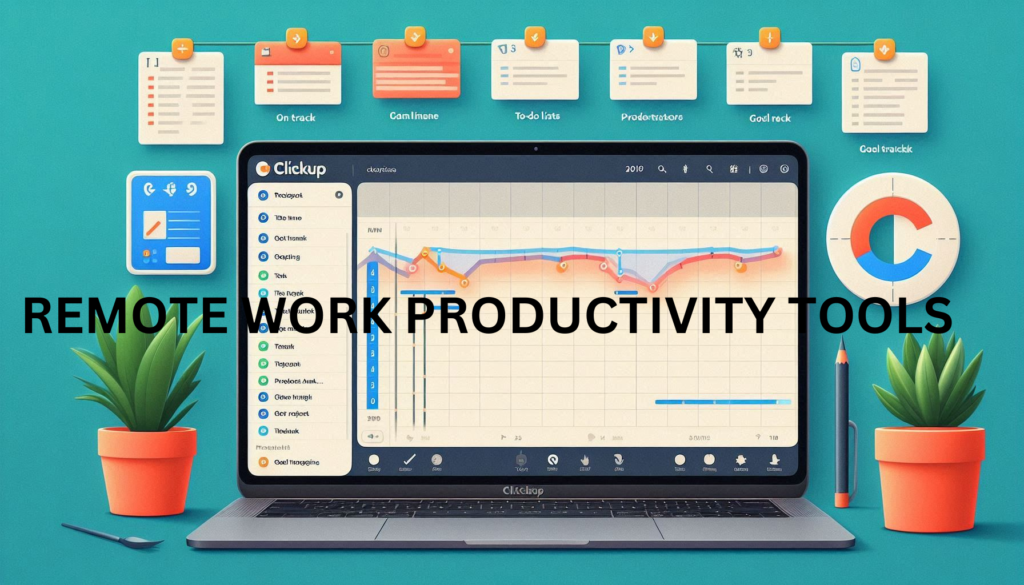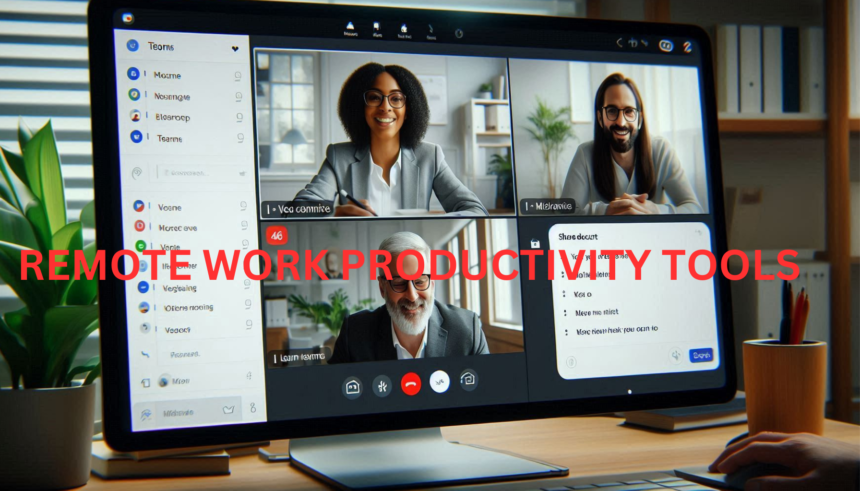As remote work remains very common in 2024, there are remote work productivity tools that help people work well from home. Whether you work alone, with a team in different places, or manage a whole company remotely, being business productive is very important. Luckily, there are many productivity tools available that can help with teamwork, managing tasks, staying in touch, and more.
This article will explore the best remote work tools in 2024, case studies, lists, and useful tips on how to use them in your work setting.
Why Remote Work Productivity Tools Matter
The move to working from home has changed how companies run, making remote work productivity tools very important for keeping teams spread out across different locations efficiently. Without the right tools, working from home can cause misunderstandings, missed deadlines, and lower team spirit.
The Challenges of Remote Work
- Lack of direct supervision: Remote workers can feel isolated, leading to decreased accountability and oversight.
- Communication gaps: Without face-to-face interaction, important details can be lost in translation.
- Task management issues: Keeping track of tasks, projects, and deadlines can become chaotic without a proper structure in place.
By integrating the right remote work productivity tools, these challenges can be minimized, promoting better workflow, clear communication, and effective task management.
Table 1: Key Remote Work Productivity Tools
| Tool | Category | Description | Key Features |
|---|---|---|---|
| Slack | Communication | Real-time messaging and collaboration for teams. | Channels, file sharing, integrations |
| Asana | Project Management | Task and project tracking, ideal for managing deadlines and workflows. | Task assignments, timelines, integrations |
| Zoom | Video Conferencing | HD video conferencing tool for meetings and webinars. | Screen sharing, recording, breakout rooms |
| Google Drive | File Sharing/Storage | Cloud storage and file sharing for easy document collaboration. | Real-time editing, access controls |
| Toggl | Time Tracking | Tracks time spent on tasks and projects for productivity insights. | Time tracking, reporting, billable hours |
| Zapier | Task Automation | Connects different tools to automate repetitive tasks without coding. | App integrations, automation workflows |
The Core Features of Productivity Tools
Not all remote work productivity tools are the same. The best ones have several important features that make them efficient and easy to use. Whether you’re looking for project management tools or communication platforms, make sure to think about these things:
1. Ease of Use: Tools should be easy to use, so people can quickly learn how to work with them.
2. Collaboration Capabilities: Allow groups to collaborate, exchange files, and communicate smoothly.
3. Integration: Software that works well with other programs helps create a smoother work process.
4. Scalability: As your team grows, the tool should grow with you.
5. Security: Good security and safe sharing of information are important for working from a distance.

Top Remote Work Productivity Tools in 2024
1. Project Management Tools
Managing tasks and projects is crucial for remote work productivity tools. Here are the best project management tools to help you stay organized:
Asana
Asana is a well-known project management remote work productivity tools that helps teams work together, assign tasks, set due dates, and monitor project progress. It includes features such as task prioritization and milestone tracking, ensuring that all team members are aligned.
Key Features:
- Task assignments and deadlines
- Gantt charts for tracking project timelines
- Integrations with Slack, Google Drive, and more
Trello
Trello is a simple and adaptable project management tool that uses the Kanban method. It helps users create boards, lists, and cards to see tasks and projects clearly, which is great for teams of all sizes.
Key Features:
- Drag-and-drop interface
- Customizable boards for different projects
- Integration with additional programs, such as Dropbox, Google Drive, and Slack
2. Communication Tools
Effective communication is crucial for a successful remote work productivity tools setup. Without the right tools, important information and ideas can be missed. These tools are vital for maintaining clear communication within teams.
Slack
Slack is a tool for team communication that is closely linked to remote work productivity tools. It lets users make different groups for various projects, teams, or topics and works well with other tools like Google Docs and Zoom.
Key Features:
- Threaded conversations for organized communication
- Integrations with over 2,000 tools- File sharing capabilities
Microsoft Teams
Microsoft Teams provides strong communication tools, such as chat, video calls, and sharing files. It works well with other Microsoft apps like Outlook and Word, making it a great option for teams already using Microsoft products.
Key Features:
- Integrated with Microsoft Office suite
- Video calls and meetings with screen-sharing- Working together on Word, Excel, and PowerPoint projects in real time.
Table 2: Tools for Enhancing Team Collaboration
| Tool | Primary Use | Best Features | Recommended For |
|---|---|---|---|
| Microsoft Teams | Communication & Meetings | Integrated with Office 365, file sharing | Large corporations with Microsoft licenses |
| Slack | Real-time Messaging | Channels, threads, app integrations | Teams needing flexible communication |
| Trello | Task Tracking & Collaboration | Visual boards, checklists, file attachments | Teams requiring task visibility |
| Google Meet | Video Conferencing | High-quality video calls, screen sharing | Teams needing reliable video calls |
3. Time Tracking Tools
Monitoring how time is used is important for being remote work productivity tools. Time tracking tools help employees stay focused and use their time well.
Toggl
Toggl is a tool for tracking time that helps people who work from home keep track of how much time they spend on different tasks. Its simple design and reporting options make it perfect for freelancers, consultants, and teams.
Key Features:
- One-click time tracking
- Detailed reports on time allocation
- Integration with project management tools
Clockify
Clockify is a free app for tracking time that lets you record time manually or automatically. It’s great for teams who want to keep track of billable hours or boost productivity by analyzing how time is spent.
Key Features:
- Unlimited tracking for projects and tasks
- Automated timesheets and reports
- Team time tracking for remote teams
4. File Sharing Tools
Effortless file sharing is crucial in remote work settings. These tools make sure that documents, images, and other files can be shared and stored safely.
Google Drive
Google Drive is a service that lets you store and share files online. It lets groups work together on documents, spreadsheets, and slideshows at the same time, and it automatically saves everything.

Key Features:
- 15 GB of free storage
- Working together in real time on Google Sheets, Slides, and Docs- Secure file storage and sharing options
Dropbox
Dropbox is a well-known tool for sharing files that also provides cloud storage and sharing options. Using Dropbox, teams can effortlessly share files of any size and work together instantly.
Key Features:
- 2 GB of free storage
- Advanced sharing permissions for file access control
- Sync files across devices
5. Video Conferencing Tools
Talking in person is very important for a team to work well together and understand each other. The best tools for video meetings make sure the video and sound are clear for discussions and working together.
Zoom
Zoom is one of the most well-known platforms for video meetings. It can be used for meetings, webinars, and video calls, and it has features like sharing your screen and small group discussions.
Key Features:
- HD video and audio conferencing
- Screen sharing for presentations
- Breakout rooms for small group discussions
Google Meet
Google Meet is a simple video meeting tool that works with Google Calendar. It’s a great choice for teams that already use Google Workspace, and it offers secure video calls.
Key Features:
- Easy integration with Google Workspace
- Secure, encrypted video calls
- Screen sharing and meeting recording options
Case Study: Remote Work Success with Asana
Company: XYZ Tech Solutions
Challenge: Managing complex projects across multiple time zones
Solution: Implementing Asana for project management and task tracking
XYZ Tech Solutions, a fast-growing remote work productivity tools tech company, struggled with managing its projects across different time zones. With employees located across the globe, the team found it difficult to keep track of tasks, set deadlines, and monitor project progress. After adopting Asana, the company saw a 30% increase in project completion rates, improved communication between team members, and a reduction in missed deadlines. Asana’s task prioritization and Gantt chart features were particularly helpful in keeping the team aligned and on track.
Key Takeaways for Maximizing Productivity
1. Choose the right tools for your team: Whether it’s project management, communication, or file sharing, select tools that fit your team’s unique needs.
2. Integrate tools for seamless workflow: Many tools integrate with each other (e.g., Slack and Asana), allowing for a more streamlined workflow.
3. Monitor productivity regularly: Tools like Toggl and Clockify help ensure that time is used effectively, providing insights into how to improve.
4. Encourage collaboration and communication: Regular video meetings and organized communication channels (like Slack or Microsoft Teams) are essential for keeping remote teams connected.
Additional Categories of Remote Work Productivity Tools
1. Task Automation Tools
In a remote work productivity tools setting, automating routine tasks can save a lot of time, letting teams concentrate on important activities. Tools like Zapier and Integromat link your preferred apps, enabling you to automate processes without needing to write any code.
- Zapier: This tool helps you automate tasks that you do over and over by connecting with more than 2,000 different apps. For example, it can automatically save attachments from Gmail to Google Drive or send a message on Slack when a card in Trello is updated.
Table 3: Task Automation Tools Comparison
| Tool | Integrations | Unique Feature | Best Use Case |
|---|---|---|---|
| Zapier | 2,000+ apps | Simple automations without coding | Basic task automation |
| Integromat | 1,500+ apps | Visual workflow builder with complex logic | Advanced automation and integrations |
| Microsoft Power Automate | Office 365, Dynamics 365 | Built-in templates for Microsoft apps | Automating Microsoft ecosystem workflows |
Key Features:
- Integrates with over 2,000 apps
- Automates repetitive tasks across platforms
- Simple to use; no coding knowledge is needed
- Integromat: Another great tool for automating tasks, Integromat links apps together and makes workflows automatic in a more visual way. It can handle more complicated setups, such as multi-step automations that include decision-making steps.
Key Features:
- Advanced workflow automation
- Visual scenario builder
- Supports more complex integrations and conditional logic
2. Focus and Distraction-Blocking Tools
A big challenge in working from home is dealing with distractions. Tools that help you focus and block distractions can help workers stay on task by limiting access to unimportant websites or apps.
- RescueTime: This time management tool works quietly in the background, keeping track of the time you spend on different apps and websites. It gives you detailed reports to help you see where you might be wasting time and offers tips to help you stay more focused.
Table 4: Focus and Distraction-Blocking Tools
| Tool | Functionality | Special Feature | Ideal For |
|---|---|---|---|
| Freedom | Blocks distracting websites/apps | Cross-device syncing for focus sessions | Long-term focus across devices |
| RescueTime | Tracks usage, blocks distractions | Real-time productivity tracking | Monitoring and improving focus |
| StayFocusd | Limits access to distracting sites | Customizable time limits for specific sites | Browser-based distraction control |
Key Features:
- Time tracking that remote work productivity tools automatically for websites and apps
- Detailed productivity reports
- Focus mode to block distracting websites
- Freedom: Freedom lets you stop distracting websites and apps on all your devices. Whether you need to concentrate on a specific project or reduce social media time, Freedom helps you stay focused.
Key Features:
- Block distracting websites and apps
- Schedule focus sessions in advance
- Sync across multiple devices
3. Collaboration and Whiteboarding Tools
Collaborative whiteboarding tools are important for brainstorming and planning projects, especially when it’s helpful to see ideas visually. These tools let teams work together at the same time, share thoughts, and work on designs, plans, or creative projects together.
- Miro: Miro is a web-based remote work productivity tools for team collaboration that lets groups work together on ideas, make flowcharts, and plan processes instantly. It’s perfect for visual teamwork, especially for design and creative groups.
Key Features:
- Real-time collaborative whiteboarding
- Pre-built templates for meetings and brainstorming
- Integration with well-known programs like Asana and Slack
- Jamboard: Google’s Jamboard is a digital tool for making ideas on a big screen, like a whiteboard. Groups can work together on the same board from different places, letting people who work from home add their thoughts too.
Key Features:
- Simple, intuitive interface
- Integration with Google Workspace
- Real-time collaboration across devices

Advanced Tips for Maximizing Productivity
To get the best results from your remote work tools, try these tips:
1. Integrate Your Tools for Seamless Workflow
One of the best ways to boost remote work productivity tools is to make sure your tools work well together. Integration helps everything run smoothly between different platforms and prevents the problems that come from switching between apps. For example, if you use Slack for communication, it’s smart to connect it with your project management tool, like Asana or Trello. This way, you’ll get notifications right in Slack, so you don’t have to keep checking different tools for updates.
Key Takeaway:
Combining your tools boosts remote work productivity tools and makes sure everyone in the team is aligned.
2. Set Clear Goals and Prioritize Tasks
Even with the best tools, remote work productivity tools can be stressful if you don’t have a clear plan. Setting clear goals and using tools to prioritize tasks helps your team stay on track. Many project management tools, like Click up and Monday.com, let you mark tasks by importance, so it’s easier to know what to do first.
Key Takeaway:
Prioritizing tasks helps teams stay focused and ensures that crucial jobs don’t get overlooked.
Table 5: Remote Work Productivity Tips
| Challenge | Solution | Suggested Tool/Method |
|---|---|---|
| Procrastination | Schedule tasks and set priorities | Asana, Todoist |
| Distraction from Social Media | Use distraction-blocking tools | Freedom, StayFocusd |
| Miscommunication | Adopt structured communication channels | Slack, Microsoft Teams |
| Overlapping Meetings | Schedule asynchronous updates where possible | Recorded Zoom calls, Loom |
| Task Overload | Automate repetitive tasks, delegate where possible | Zapier, Integromat |
Conclusion: The Future of Remote Work Tools in 2024
In 2024, remote work productivity tools are more important than ever. There are many kinds of tools, like task automation, project management, distraction-blockers, and collaborative whiteboards. These tools help teams stay productive no matter where they are.
To get the most out of your remote team, it’s important to pick the right tools for your needs, use them well together, and use data to keep making things better. As working from home keeps changing, using the right tools will be the way to stay ahead.
FAQ
1. What are the most important tools for remote work productivity?
The most important tools are those that help with project management, communication, time tracking, and file sharing. Examples include Asana, Slack, Toggl, and Google Drive.
2. Do you boost productivity while working remotely?
Productivity tools help streamline workflows, improve communication, and keep teams organized. Tools like Slack facilitate real-time communication, while Asana helps track tasks and project progress, ensuring deadlines are met.
3. Can I use multiple productivity tools together?
Yes, many tools integrate seamlessly with each other. For example, you can use Asana for project management and integrate it with Slack for communication, or use Toggle alongside both for time tracking.
4. What are the best time-tracking tools for remote work?
Some of the best time-tracking tools for remote work include Toggl, Clockify, and Harvest. These tools help track billable hours and monitor how time is spent on various tasks.
5. How do I choose the right productivity tool for my team?
Start by identifying your team’s specific needs. If you need help managing projects, consider tools like Asana or Trello. For communication, tools like Slack or Microsoft Teams are excellent choices. Look for tools that integrate well with your existing workflow and can scale with your team’s growth.
